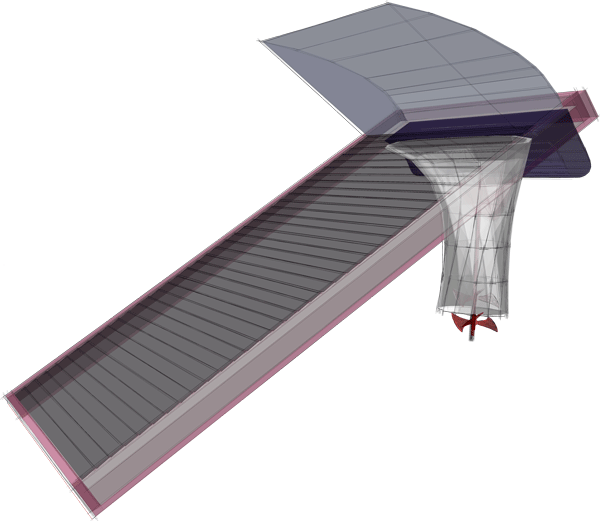Technical Description

A solar air heating – Ventilation aluminium (VentAL) system has been developed and applied on the inclined south facing roof while the facades feature a variation of the system consisting of double glazing panels with internal movable aluminium louvers.
The VentAL System
Is a solar air heating system—a metal collector exposed to solar radiation―incorporating some innovative techniques:
- The metal collector is an array of especially designed rotating louvers consisting of two fins. During heating season the absorbing perforated fins are exposed to solar radiation while during cooling season the highly reflective fins are used.
- A fan is used to force air through the system improving heat gain. The fan is powered by a low temperature difference Stirling Engine (LTDSE). Aluminium, with a melting point of about 600°C, but with a vastly superior thermal conductivity than stainless steel, is used for the heater system of LTDSE.
- In order to maximise solar radiation impinges on the LTDSE collector an aneidolic concentration system (with efficiency factor of 4) was used. Due to the orientation and the form of the concentrator, winter time radiation can be used while during summer the concentrator itself shades the LTDSE heater efficiently.
- Average temperature rise is 15 degrees Centigrade while LTDSE efficiency is ~17%.
- A custom designed type of manifold distributes hot air in the interior.
- Modularity is a key function of the system permitting
- connection of multiple units in rows
- use of alternative technologies like photovoltaics instead of stirling engines
- use of glazed surface instead of rotating louvers.
VentAL uses
The system can be used to reduce heating loads during winter and to assist ventilation and solar protection during summer. The change of operation mode can be performed manually and can be installed in new or retrofit applications.
Daylighting strategy
In developing the daylighting concept of the building envelope, the target was to guide daylight in the core since the perimeter areas have access to large glazing panels. A zenithal aneidolic system was designed, achieving a three-fold increase on floor illumination during winter solstice under clear sky conditions. Another advantage of the system is the small roof openings needed, avoiding excessive solar heat gains during summer.
Ventilation
Ventilation was a key topic in the design since warm air from VentAL system is driven into the interior during the heating period. To avoid stagnation of warm air due to buoyancy, a special type of manifold with enclosed fans was designed.
During the whole year, cross ventilation can be used via a series of two opening families placed in the north and south facades. The south opening is locating at a height of 11m and is used as a “venturi” extractor.
Results
Simulation tools have been used in order to estimate the energy savings produced by the operation of the systems analysed above. For these simulations the following assumptions have been used:
- Occupancy: 200 people
- Computers in operation: 25
- Infiltration 0.05 ACH (the space has a volume of 25303 m3 )
- Set point temperature for summer and winter 280 and 180 respectively. Space is used as circulation area which explains the difference of set point temperatures from the established standards.
- Ventilation rates needed were 26 m3/h/person.
- When VentAL is not in use, a fixed shading system is applied in all south oriented glazing, achieving on average 50% shading. With VentAL in operation, 100% shading is achieved during summer with the inclination of the south façade and the geometry of the system louvers maintaining visual contact with the exterior.
Simulation showed that with the VentAL system in operation throughout the year, there was a 58.6 % reduction for heating loads and 65% (from 93100 kWh to 31800 kWh) for cooling loads leading to a 30.6 tonnes/annum reduction in CO2 emissions. Even larger savings can be achieved if the comparison is performed between the new skin and the old one.
In terms of costs, if the VentAL system is not considered as a separate system but as part of the building skin then there is no payback period. As the system produces 50-100 kWh/m2 it can have a payback period between 10-20 years.
Simulation tools used
ESP-r, Radiance , Aiolos, RETScreen

